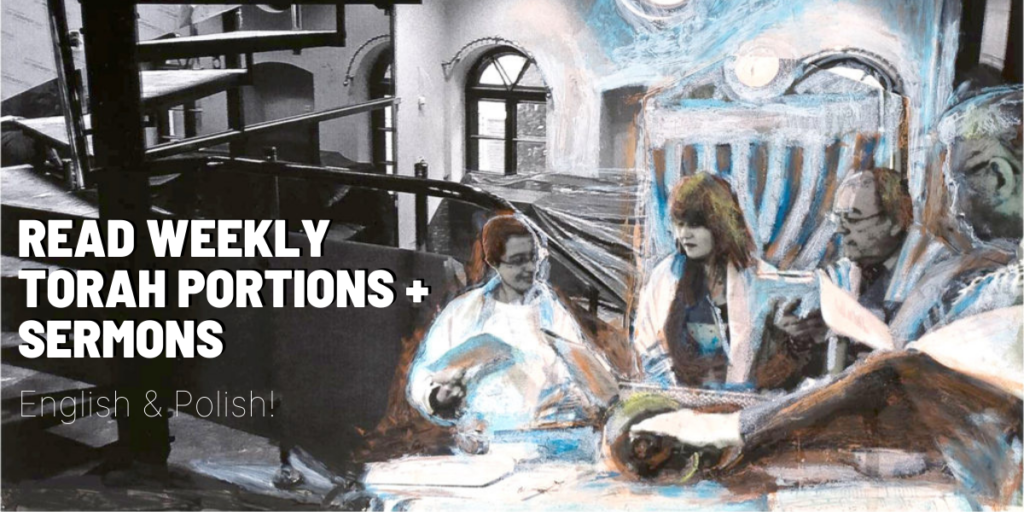
Rabbi Dr Walter Rothschild
[maxbutton id=”6″ url=”https://polishjewsreviving.org/ree/” ] Beit Warszawa, 30 August 2019 – The portion ‘Re’eh’ is one of those composite ones towards the end of the Torah where Moses is trying to cram in several themes at the same time. Some are, from our point of view, pleasant and uplifting, some are violent and threatening. When he starts by saying ”Look, today I put before you the Blessing and the Curse” – he means it!
We are not used to curses very much these days. Political insults yes, but it is amazing how often I, as a Rabbi (I am not a priest!) have been asked to ”say a blessing” or ”give a blessing” or ”Deliver a blessing” (how? Like a takeaway pizza? Should one be able to call a number and request a ”Set of blessings, please, with an extra portion of benevolence”?) Yet I am never asked to deliver a curse. Why not? The anger, bitterness and hatred which people keep inside themselves for people they would wish to curse, they tend to keep inside themselves instead, and not admit it to others – not even their therapists. Some will eventually explode violently and even lethally, which is tragic for all concerned, because in such cases it is often people totally unconnected to a conflict who get drawn into the casualty lists. Would it perhaps be better to sit in a darkened room and light a candle and utter a list of curses against some enemy? There are some wonderful Yiddish curses which seem to have been a part of daily normal speech. One I like is: ”May all your teeth fall out – except one, and that one should have toothache!” One with a sting in the tail is, ”May a child be named after you – And soon!” – the idea being of course that the child would be named after a deceased relative.
How would a Curse work? The sidra gives some insight into the fate planned for the native religions, which – from the Israelite point of view – were to be cursed, not respected or preserved or even absorbed, when they get into the Land and conquer it and its inhabitants. ”Destroy all their holy places where they served their gods, and break down their altars, and destroy their pillars, and burn their idols…” and so it goes on. (Deut. 12:2-3). These are not the sort of verses that fit well into an interreligious event. Instead, the Israelites are commanded to bring their offerings to one specific place only, a place that God will choose and decide. This will be, as we later know, the Temple at Jerusalem. Nowhere else. (Which, of course, makes things difficult if that place has now become the shrine of another religion…… but is this a matter of Politics, or Theology?) When the land is conquered, in the Book of Joshua, many of these commands will be fulfilled.
Quite often in human history the shrines and temples of the defeated gods – that is, the gods of the defeated side – are destroyed. But not always. It is interesting that in some cases one victorious or triumphant religion has indeed simply taken over the shrine of another defeated and humiliated religion – think of the large Hagia Sofia mosque at Istanbul, which used to be a Christian church; many churches themselves were built near or on the site of earlier pagan shrines. Presumably the locals were used to coming here, maybe there were geographic reasons or even invisible energy lines, ”ley lines’, and so the shrine was where it had always been, just ”under new management”.
What I find fascinating – here in Poland – is how in certain parts of the country in 1945 the existing Protestant population was expelled and replaced by a new Catholic population, moved in forcibly from somewhere else. What did they find in their new homes? A Christian church. But a different kind of Christian church. Dedicated to the same God and the same Son of God but – different. Not enough statues or paintings or baroque bits and pieces! A part of me simply wonders: What was it like, in those very difficult days – let us not forget how everyone had suffered, how food and everything else was in short supply, how almost everyone had been bereaved, and more – and one day you, as a priest, are summoned to some local bishop or some local commander or new civil administration and given the keys to the local church and told ”Go in and clean it up and take it over.” Assuming the building had not been severely damaged by bombs or shells, you would go in and find – well, what? A font for baptising Christian babies; an altar for Christian rituals; Crosses; Also Bibles and prayer books and song books – all for addressing God, albeit in a foreign language, in German not Polish…. What could you use, what would you stack in a corner or a back room with a degree of reverence, what would you throw out or sweep away or burn? How would you prepare your first services for your new uprooted flock in a church which had been built and cared for and loved for generations of worshippers but now hastily abandoned by these fellow Christians? Addressing the same God in the same place, but in Latin or Polish rather than German?
It is possible that someone has researched this or written some autobiography but if so, presumably in a language I do not know. I have read how railwaymen were sent to take over and restore to use damaged railway stations, signal boxes and depots. It was not easy, and not just because of the ammunition and corpses still lying around. But someone had to be the first man to open the door – hoping it was not booby-trapped – or pick up the fragments or draw up a list of what had to be done. Someone had to take responsibility and find what the people needed – shelter, food, medical care, clothes, hygiene articles, running water, fuel – and spiritual care.
It would not take long for the former inhabitants to be forgotten and the new ones to feel more settled in. It would not take long for a different smell to fill the holy buildings, a different form of furniture polish, a supply of incense, and different voices would sing perhaps the same hymns and psalms but in a different tongue and to different melodies.
And what would God think about all this?
Forgive me but – these flashes of curiosity have always been with me. The desire to look beyond the bare text and create scenarios, whether realistic or not, to demonstrate how things might have happened. We as Jews often mourn for the destroyed Temple of Jerusalem and for destroyed synagogues, but Europe and elsewhere is littered with the ruins and remains of places that were once holy to someone or other but are now – if anything much is left – just tourist sites. If the IS got there, then almost nothing is left……. When Moses commands ”Destroy their altars!” – who would feel capable, authorised, even safe, not afraid of some divine punishment, some kicking back from whatever was left of the divine force that had once been assumed to be embedded there? Would only the priests, the Cohanim, feel so commissioned?
Judaism found an ingenious way round this problem. The religion was transferred from a shrine into our heads; from an altar into our hearts. That way we could take it with us wherever we went, independent of pillars and priests and pomp. Of course, and tragically, that did not stop people trying to stamp out Judaism by forcibly taking over Jewish souls, or by killing Jews…. usually in the name of the same God.
Yes, the question remains: What DOES God make of this all?
Shabbat Shalom.
Rabbi Dr. Walter Rothschild.


















Leave a Reply